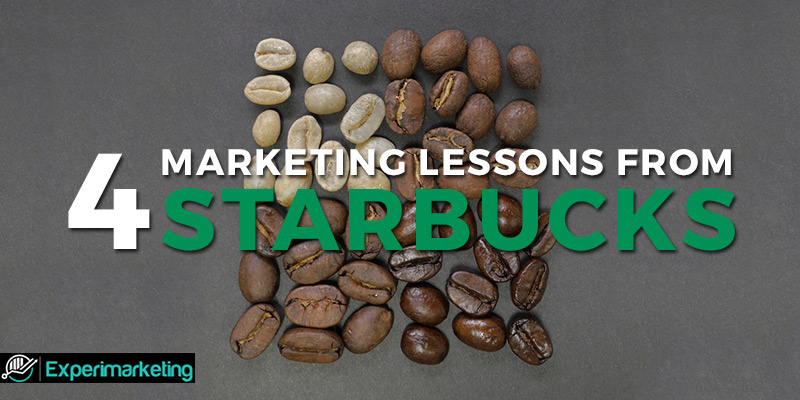With locations in almost 70 countries, Starbucks has become one of the most powerful global brands. From malls to airports and everywhere in between, it can be difficult to not find a Starbucks location within a five-mile radius of you.
Born from a single store in 1971, the chain grew their product offering from roasted whole coffee beans to a wide variety of fresh and packaged products through different brands, including Evolution Fresh and Teavana.
Along the way, Starbucks has accrued a massive following, bringing in over $16B of revenue in 2014.
How do they do it? The first three big lessons to be learned from their practices are:
- How to communicate
- How to cultivate loyalty
- How to implement consistency
Even if your business isn’t a massive multinational, there’s still plenty that you can learn from the beverage giant and use in your own applications:
Communicate
One of the major keys to success for Starbucks is how they speak to their customer, literally and figuratively.
In the literal sense, every piece of communication is thoughtful and on-brand. From social media posts to the interaction and transaction in-store, Starbucks has been able to create a tone that is consistent (more about that below) and appealing, allowing for content and conversations with its customers.
The brand, however, doesn’t always get the chance to speak directly to its customers, so they communicate figuratively instead. The language they use is just as impactful for the brand when it’s not a direct communication. A prime example of this is in their printed materials. A product description isn’t direct communication, but the company is still able to use language to their advantage.
For example, one of the newer Starbucks ventures in Starbucks Reserve, a product line of small-batch roasted coffees available already-brewed in their hometown of Seattle and for purchase at select locations and online. With each product, Starbucks has taken the time to discuss what makes their selections so great by providing a background as to why that coffee was chosen for Reserve.
On both of these levels, Starbucks has used language to create something that a customer can identify with. Not every message will resonate with every customer, but with effective communication, the company is able to market itself to a wide market. In a highly competitive industry, that ability is invaluable to their success.
Loyalty
Starbucks has also created a loyalty program that all but ensures its customers keep coming back for more. Called My Starbucks Rewards, little investment is required to sign up (registering a gift card or downloading the app) and every purchase made with the account is rewarded. Managed by an online account accessible on both computers and mobile devices, the program allows for both card and mobile payments, making it easy to use as well.
With few barriers to entry in the program, Starbucks has been able to cultivate a following that few companies can hope to achieve. Last summer, program members (repeat customers that took the extra step of signing up for rewards) made up 30% of total business in North America.
Having that kind of repeat business means that Starbucks can connect with their customers on an extra level, including personalized rewards or incentives to try other products, using data from members’ purchase history.
Loyalty plays a large role in marketing and business success. With continually satisfied customers, loyalty and relationships are built, which can lead to customer retention and increased profitability.
Repeat customers are also beneficial, as they can provide both implicit and explicit endorsement, a wider network to communicate to and feedback to help improve and optimize.
Consistency
Though there are some regional Starbucks products and services, the core offering is identical across all locations. This consistency extends to their stores as well — there are several different styles, but the experience remains the same.
It’s inherently comforting to know that, as a customer, you can walk into any Starbucks and receive the same product and treatment wherever you are in the world. This goes a long way in building loyalty and customer experience.
The uniformity of the brand also helps. Continuous use of the logo and its hallmark green make for a brand recognition of over 90% in both the United States and the United Kingdom. Even though the logo has undergone a few changes over the course of its lifetime, its application has remained the same.
Consistency, however, doesn’t mean always sticking to the straight and narrow. The company has shown that they are willing to grow with the times and try new ways to connect with their customers.
Even in their bolder marketing initiatives (giving the Pumpkin Spice Latte its own social media accounts, for example) Starbucks stayed true to form by ensuring they executed in the same way they do with other, more traditional campaigns.
The fourth, and biggest, lesson of all? Relationships are key. Using communication, loyalty and consistency as marketing tools creates powerful relationships between the brand and its market.
Being able to give the customer something to identify with is critical in relationship development. Despite serving millions of individuals every year, Starbucks has been able to connect with a significant segment of them in various ways to build and retain customer relations:
- 4 million My Starbucks Rewards members
- 5 million Twitter followers (US account)
- Over 36 million Facebook likes
Forming relationships is clearly a key component of success for the company, so it’s no surprise that Starbucks is currently on a five-year streak of revenue-per-share growth.
